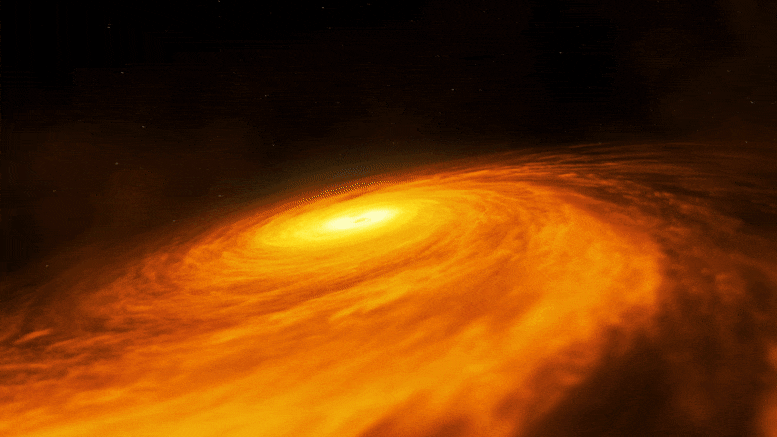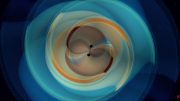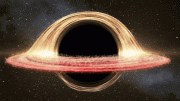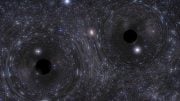
Artist’s impression of a disc of material circling a supermassive black hole. Credit: ESA/Hubble, M. Kornmesser
Simulation Shows How Star Collisions Fuel Massive Black Holes
New model shines light on the mysterious origins of Gravitational Wave 190521.
It’s challenging to predict with certainty what will happen when giant stars collide. However, new, first-of-their-kind hydrodynamic simulations by the DEMOBLACK team at Italy’s University of Padova point to a range of exotic outcomes. Those include building up massive black holes in stellar nurseries, where big stars reside close together.
Astrophysicist Michela Mapelli described the new simulation and its predictions during a session at the APS April Meeting 2022. The hybrid meeting was held in New York City and online. In addition to Mapelli, the DEMOBLACK project includes astrophysicists Alessandro Ballone and Guglielmo Costa.
Mapelli’s model suggests an answer to a pressing question in the field of gravitational wave astronomy: How did two distant black holes combine to produce GW190521, a powerful gravitational wave detected in 2019 by Advanced LIGO and Virgo? The signal for GW190521 had the characteristic form of a black hole merger. In this case, it was between two progenitor black holes with masses of 85 and 66 solar masses. Their collision gave rise to a black hole remnant more than 140 times as massive as the sun.
Gravitational waves are disturbances or ripples in the curvature of spacetime caused by accelerating masses that propagate as waves outward at the speed of light from their source.
But the merger was a head scratcher. It was bigger than stellar-mass black holes, which form from the collapsed cores of stars, and smaller than supermassive ones. Its mass landed it in a “mass gap” — a range in which physicists weren’t sure black holes could form.
Mapelli and her collaborators first predicted that stellar collisions might lead to the formation of black holes in the mass gap about a year before the LIGO-Virgo observation was announced. They didn’t run a hydrodynamical simulation, however, until they learned more about GW190521. “It made us roll up our sleeves,” she says.
According to the DEMOBLACK simulation, such a behemoth could arise when big stars, like those found densely packed in a stellar nursery, unite. Previous simulations have modeled collisions between low- and medium-mass stars, but Mapelli’s work, for the first time, describes what happens after giants smash together. “Nobody has done the simulation of the collision of stars that are so massive,” she says.
At the APS meeting, Mapelli described dynamical processes that may underlie the formation of massive binary black holes in young star clusters. The simulation begins with two stars, one of which is a main sequence, physically unevolved star about 40 times as massive as the sun. “It’s mostly fresh hydrogen,” she says. The other star is older, is about 60 solar masses, and has a compact core of helium. “This means the radius is very large, the mass is large, and the contrast between the density of the core and the outer part is large,” says Mapelli.
Under some assumptions, those stars could collapse into a black hole with more than 50 solar masses. And those black holes, in turn, could form binaries and ultimately merge. According to Mapelli, these kinds of stellar exchanges and collisions can build up binary black holes with more mass than 40 suns. Repeated collisions and mergers could produce black holes of much higher masses, ranging from about 100 to 10,000 times the mass of the sun.
Since the observation of GW190521 reported in the journal Physical Review Letters in 2020, theorists have sought a rigorous explanation for the dynamic processes behind it. A competing idea posits that the binary included primordial black holes, which means they arose not from the collapsed cores of stars but were left from the early universe. Another, bolstered by the observation that the merger may have produced an electromagnetic flare, suggests that the collision happened inside the dense gas disk surrounding a supermassive black hole.
Mapelli says her work doesn’t rule out those other explanations. “We are not sure that this collision is the only possible explanation for an event like 190521,” she says. “This simulation does not reject the other ones. We need to consider the three of them.”
APS April Meeting 2022: Abstract: S03.00001 : Mass-gap black holes and the nursery of stars









Be the first to comment on "Star Collisions Fuel Massive Black Holes: Mysterious Origins of Gravitational Wave 190521"